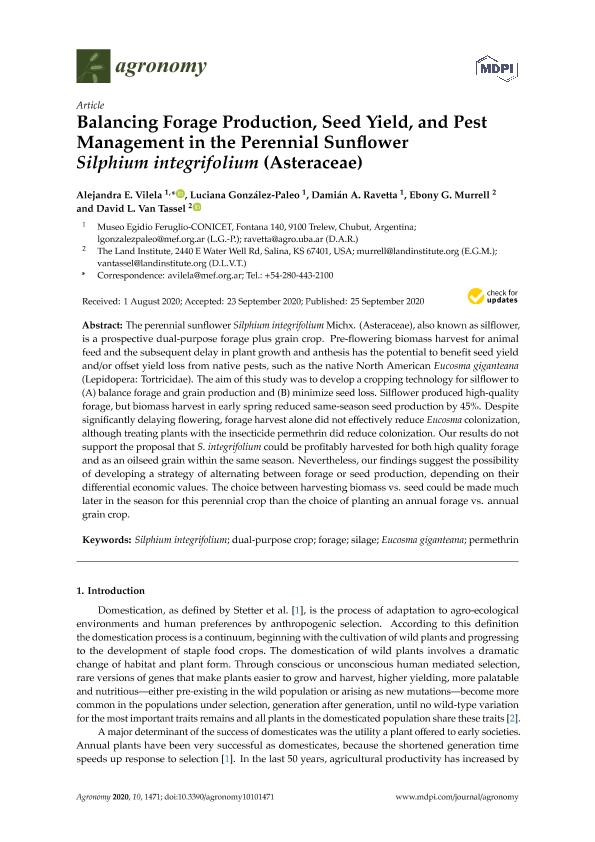Artículo
Balancing forage production, seed yield, and pest management in the perennial sunflower silphium integrifolium (Asteraceae)
Vilela, Alejandra Elena ; González Paleo, Luciana
; González Paleo, Luciana ; Ravetta, Damián Andrés
; Ravetta, Damián Andrés ; Murrell, Ebony G.; Van Tassel, David
; Murrell, Ebony G.; Van Tassel, David
 ; González Paleo, Luciana
; González Paleo, Luciana ; Ravetta, Damián Andrés
; Ravetta, Damián Andrés ; Murrell, Ebony G.; Van Tassel, David
; Murrell, Ebony G.; Van Tassel, David
Fecha de publicación:
10/2020
Editorial:
Multidisciplinary Digital Publishing Institute
Revista:
Agronomy Journal
ISSN:
0002-1962
e-ISSN:
2073-4395
Idioma:
Inglés
Tipo de recurso:
Artículo publicado
Clasificación temática:
Resumen
The perennial sunflower Silphium integrifolium Michx. (Asteraceae), also known as silflower, is a prospective dual-purpose forage plus grain crop. Pre-flowering biomass harvest for animal feed and the subsequent delay in plant growth and anthesis has the potential to benefit seed yield and/or offset yield loss from native pests, such as the native North American Eucosma giganteana (Lepidopera: Tortricidae). The aim of this study was to develop a cropping technology for silflower to (A) balance forage and grain production and (B) minimize seed loss. Silflower produced high-quality forage, but biomass harvest in early spring reduced same-season seed production by 45%. Despite significantly delaying flowering, forage harvest alone did not effectively reduce Eucosma colonization, although treating plants with the insecticide permethrin did reduce colonization. Our results do not support the proposal that S. integrifolium could be profitably harvested for both high quality forage and as an oilseed grain within the same season. Nevertheless, our findings suggest the possibility of developing a strategy of alternating between forage or seed production, depending on their differential economic values. The choice between harvesting biomass vs. seed could be made much later in the season for this perennial crop than the choice of planting an annual forage vs. annual grain crop.
Archivos asociados
Licencia
Identificadores
Colecciones
Articulos(SEDE CENTRAL)
Articulos de SEDE CENTRAL
Articulos de SEDE CENTRAL
Citación
Vilela, Alejandra Elena; González Paleo, Luciana; Ravetta, Damián Andrés; Murrell, Ebony G.; Van Tassel, David; Balancing forage production, seed yield, and pest management in the perennial sunflower silphium integrifolium (Asteraceae); Multidisciplinary Digital Publishing Institute; Agronomy Journal; 10; 10; 10-2020; 1-14
Compartir
Altmétricas



